Mastering Nullable Value Types in C#
2 min read · — #csharp-interview#junior#nullable-value-types
Navigating the world of C# requires a thorough understanding of its various features, and among those features, Nullable Value Types hold a distinctive position. The C# programming language is renowned for its robust type system which encompasses both value and reference types. However, what if you're faced with a situation where you need a value type to represent the absence of a value? Enter Nullable Value Types. These are indispensable when dealing with databases, UI inputs, and situations where a value might or might not be present. As a budding C# developer, mastering this concept is crucial, especially when gearing up for technical interviews. In this post, we'll delve deep into Nullable Value Types, illustrating with pertinent examples to ensure you're well-prepared for any curveball thrown your way during that interview.
1. Basics of Nullable Value Types
In C#, value types (like int, double, bool, etc.) cannot be assigned a null value by default. However, sometimes
you need a way to represent the absence of a value. That's where Nullable Value Types come into play.
Syntax:
Nullable<T> variableName;OR
T? variableName;Where T is a value type.
Example:
int? number = null; // Using shorthand syntax with '?'
Nullable<int> number = null; // Using longhand syntax with 'Nullable<T>'2. Assigning and Accessing Nullable Value Types
Nullable types can be assigned values just like their non-nullable counterparts.
Example:
int? age = 25;
double? weight = 70.5;
// Accessing value
int currentAge = age.Value; // Throws an exception if 'age' is null3. Checking for Value Presence
Always check if a nullable type has a value before accessing it.
Example:
if(age.HasValue)
{
Console.WriteLine($"Age is: {age.Value}");
}
else
{
Console.WriteLine("Age is not specified.");
}4. Using the Null Coalescing Operator
The null coalescing operator (??) provides a concise way to define a default value if a nullable type is null.
Example:
int? score = null;
int finalScore = score ?? 0; // If 'score' is null, finalScore will be 05. Nullable Value Types with LINQ and Databases
When working with databases, especially with Entity Framework, you'll encounter scenarios where a field might be optional. In such cases, Nullable Value Types are extremely beneficial.
Example:
Suppose we have a Students table with an optional GraduationYear field.
public class Student
{
public int Id { get; set; }
public string Name { get; set; }
public int? GraduationYear { get; set; } // Nullable int type
}Conclusion
Nullable Value Types in C# offer a versatile solution for scenarios where value types need to represent the absence of a value. Whether it's database interactions, error handling, or user input management, they find utility across the board. Before your next technical interview, ensure you're comfortable with this concept, practicing with examples and understanding the underlying theory. Happy coding!
